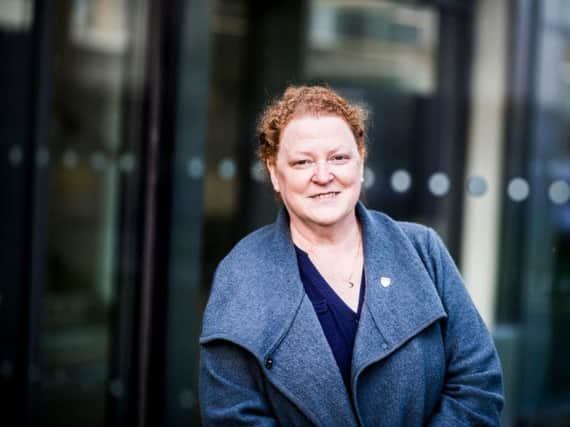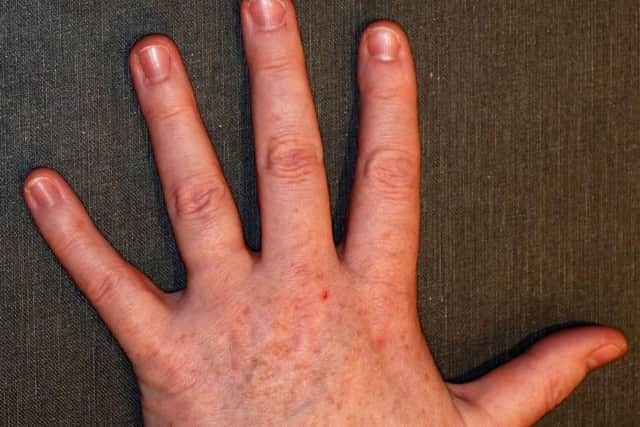Hands up if you want to help catch criminals


Do you want to help scientific research?
Well, here is a simple first step to take ...donate a photo of your hands.
Yes, really.


Lancaster academic and Pro Vice-Chancellor for Engagement Professor Dame Sue Black is working to identify criminals through the uniqueness of their hands.
Advertisement
Hide AdAdvertisement
Hide AdThe aim is to harness technology to help identify those responsible for terrible crimes - and that’s where the public can help.
Sue assures the public their data,the phone photos, will be held anonymously – and at the end of the research project destroyed.
But for the expected five/six-year life of the project, which is being run in collaboration with the University of Dundee, those taking part will be assisting what this world renowned forensic anthropologist sums up as ‘a very important project.’
The £2.5m Eurofunding for the project which is named H-Unique, has come through the European Research Council. The pioneering project will create the world’s first searchable database of the anatomy and variations of the human hand.
Advertisement
Hide AdAdvertisement
Hide AdShe notes the timing of the funding, as Brexit looms, means it is “literally, just in the door.”
The origins of the research go back 10 years when the high-flying academic,formerly based at The University of Dundee, pioneered this work after being called in to assist in a case where a young girl had claimed her father came into her room at night and abused her.
Sue recalls: “She told her mother and she didn’t believe her.”
The youngster decided to leave her camera running on her computer and the infrared technology meant that on the picture of the suspect’s hands, taken in the dark, the veins stood out.
Advertisement
Hide AdAdvertisement
Hide AdSue said: “Veins are very variable. The pattern in the right hand is different from the left and it’s different in identical twins.If you looked at the pattern of the suspect and it as different from that in the photograph that would mean it was not him. If it is the same it means the suspect cannot be excluded from the inquiry.”
It was the first time such evidence had been used in court and afterwards it was agreed that, if further developed, the technique would be of immense value in the criminal justice system.
That work and research has now helped police to secure 28 life sentences and thousands of prison sentences for individuals convicted of what Sue describes as “the most heinous of crimes against the most vulnerable in society – sexual crimes against children.”
Significantly, there has been another key change. She said: “82 per cent of cases result in a change of plea. That’s really important. It saves a huge amount of time and money in courts and victims like that young girl don’t have to go and give evidence.“
Advertisement
Hide AdAdvertisement
Hide AdBut, and it’s a very big but, Sue says police cannot keep up with the sheer number of cases: “It’s crime on a gargantuan scale.”
With limited time and manpower it was time to ask a question: - would it be possible to use machines and artificial intelligence to help with the identification part of the process – and would it be possible to maintain the level of accuracy needed?
The insight that hand anatomy is more unique than DNA has powered the research.
Which gets to the crux of the project and why assistance is needed from so many members of the public: “We need huge amounts of data so we can train a computer to find and extract this pattern...to do that with large numbers of images we need to have a large data set.
Advertisement
Hide AdAdvertisement
Hide Ad“We want to set up a research database of the hands where we strip out all identity information of the individual, not trace it back to a name, email address etc or anything like that. We want an anonymised set of images we can train our computer on... We are asking for 5,000 members of the public.”
The project will combine “hard biometrics” such as fingerprints with “soft biometrics” e.g. superficial vein pattern, skin crease pattern, scars, tattoos and pigmentation.The work will be supported by an interdisciplinary collaboration between anatomists, anthropologists, geneticists, bioinformaticians, image analysts and computer scientists.
Dame Sue said: “The hand retains and displays many anatomical differences due to our genetics, development, environment or even accidents, so each person’s hand are different. Now for the first time, researchers will analyse all the factors that make a hand truly unique so we can understand and use them reliably as evidence to identify individuals.”
Already they have had nearly 800 offers of help from across the world, including many from Scotland, where Sue was formerly based, and many from Lancaster University undergraduates.
Advertisement
Hide AdAdvertisement
Hide AdShe said: “People are rising to the challenge. It’s citizen science. We’re involving citizens. On our website we’ll feed back to the community every time we publish a paper or find something new.”
Her project team is still being appointed and Sue said: “We’ll hold your email for the moment and when our team is in place they will get back in touch and tell you what images we want to take of your hand just using your mobile phone.”
Anyone over 18 is welcome to take part and she offers reassurance: “When the project is finished in five or six years time the entire database is destroyed.
"It’s important for public security and protection and their privacy.”
* To take part email [email protected] or see www.lancaster.ac.uk/h-unique